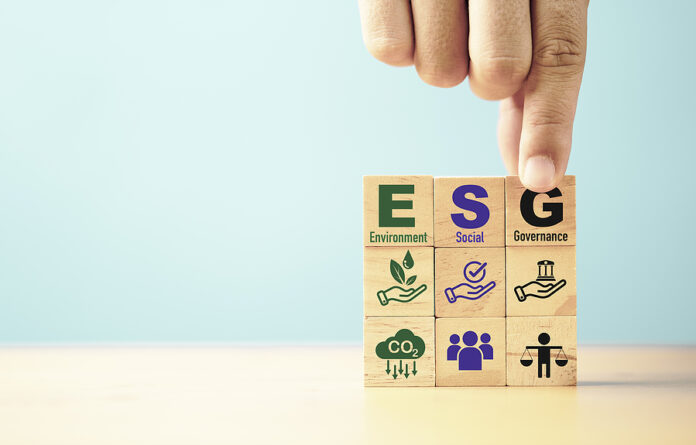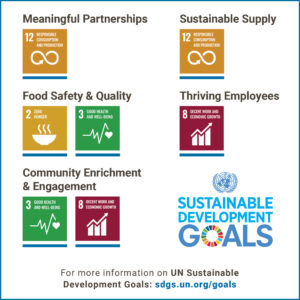
By Mat Bartkowiak, VP of Corporate Responsibility and Development, Nelson-Jameson
If you’re in a position where you have been tasked with launching a formal environmental, social, and governance (ESG) program at your food company, it can be remarkably overwhelming. If you don’t have experience working in the area, it can feel like a deluge of acronyms, a chorus of demands, and a cacophony of voices asking for different things. The reality is that creating a meaningful and impactful program is a lot of work, as well as an investment in time and resources. However, you’ll likely also find that it is work that will drive an immense sense of possibility, passion, and purpose to make meaningful change that benefits your community, your employees, the environment, and your bottom line. People want to do business with companies they trust and that they enjoy doing business with (the same goes for employees!); ESG is a great way to further build that with all kinds of stakeholders.
The following are initial steps to consider for helping the journey ahead, as well as considerations to keep coming back to throughout. ESG programs are not simply policies with boxes to check but instead are cultures to build and maintain. Embracing transparency and authenticity in your process will help establish a program that stakeholders can invest in and trust. That means being willing to pursue, grow, and also learn from your mistakes in the process.
Find mentorship
One of the most powerful guiding lights when navigating the ESG waters is to find a group of professionals and events that start to expose you to key topics, debates, and, most importantly, people that are in the same boat tackling ESG at their respective companies. Initial feelings of being lost or overwhelmed incrementally give way to empowerment by learning about a variety of topics, concerns, and targets that people are working on in the industry. It’s also a place to establish relationships with people that are at all levels of the ESG journey. These connections can become invaluable resources to review with your peers, discuss with your teams, and challenge you to create your own paths forward, while building off of resources that have already been successfully implemented.
These opportunities can take many forms, from targeting specific panels at conferences to seeking out industry organizations that feature ESG events to participating in regional organizations that look across different industry lines, workshops, and webinars. It could also mean engaging in a third-party certification program that offers educational opportunities and guidance materials, while also providing feedback and scoring (even the very initial, basic) efforts you have made so far.
Search for these organizations in your respective areas of the food industry and geographical locales, as they will provide an array of resources to assist you in your ESG journey. However, it’s important to know that these aren’t one and done opportunities. You can’t “solve” ESG with one trip, conference, or one organization, but what you can do is take significant, meaningful steps forward with the help and guidance of resources and people that have developed resources and learned from their own experiences in building ESG programs.
Think holistically
“ESG” is a totality: environmental, social, and governance concerns represent an array of potential areas of development, focus, and stewardship. Each of the three areas is about understanding where your strengths are, and where additional resources could be utilized to create goals and targets that will impact your business’s footprint on the environment, your community, and your employees and customers. Though a wide array of topics are covered in “ESG,” it comes down to what your company is willing to authentically address and target as key areas of development and investment. This is where that notion of “culture” really comes into play. The efficacy of an ESG program not only reflects your greenhouse gas emission targets or waste reduction goals, but also labor practices; sustainable sourcing practices; community involvement and investment; diversity, equity, and inclusion; ethical business practices; employee health and wellbeing; economic growth; training and development programs; and many other facets.
Companies may decide to focus only on certain areas, and that’s okay! You can’t take on everything at once. However, by linking stewardship and service to ESG goals across the organization, you build an ethos of care and service for your partners and customers and can attract and retain employees looking for more than a paycheck. People want what they do to have purpose. If ESG becomes merely a checklist or a numeric value that exists in a vacuum, the cracks in the foundation of your program will quickly show.
Build on who you are and consult stakeholders
One of the best places to start is to take stock of what your company is already doing. For instance, many companies already contribute to community organizations, have policies on workplace ethics, and provide continuing education and training opportunities. This is also a great chance to break down silos between departments by taking stock of what practices they are engaging in that might qualify for further efforts and resources. For example, perhaps your operations team is already tracking fuel consumption in your fleet vehicles; there is a possible target right there! Creating an ESG program doesn’t mean starting from scratch. It can reflect the strengths your organization already has in place: taking care of your employees, your community, and your stakeholders.
Consulting sustainability resources like the United Nations Sustainable Development Goals, GRI Standards, along with working with third-party assessment services will help to conceptualize how your existing efforts may fit into target areas. Additionally, these resources can be remarkably helpful tools in setting the table for your ESG program: a materiality assessment.
Materiality assessments are essentially a formalized check-in with an array of your stakeholders to see what ESG issues are important to them, and where your stakeholders (customers, suppliers, business organizations, board members, and employees) think your company can make the most significant impacts. This is a great tool in building a program as it allows stakeholders within and outside of an organization to weigh in on areas of interest and investment. It also allows a chance to confirm already set notions of importance, as well as challenging preconceptions, too! New York University has an excellent resource titled “Sustainability Materiality Matrices Explained” that is free to access and provides key insights into the process, key themes, and trends.
Be authentic
You can’t market your way into creating a meaningful and lasting ESG program. The creation of these programs requires tactful, incremental change with infrastructure built up to support your targets and goals. This takes real resources, time, and investment from company leadership. Be careful of the claims you make, and don’t create headline-grabbing targets without thinking through how you will reach them. The public has become very wary of greenwashing, and sometimes less-than upfront representations of how companies are working on ESG.
Take your time and build structures of support, and don’t feel the need to take on everything at once. Your stakeholders, especially your employees, will respect small steps/wins versus promising everything and working backwards from there; it is building your ESG culture. Being transparent and open with your stakeholders throughout the process helps to establish credibility in each of those small steps taken. Remember, you aren’t winning/solving ESG. Instead, you are part of a process of continuous improvement, conversation, and learning that intends to make our companies, our communities, our industries, and our world a more sustainable place to live and work.
 Mat Bartkowiak is VP of Corporate Responsibility & Development at Nelson-Jameson, a supplier to the food and dairy industry. Bartkowiak leads the company’s stewardship of environmental, social, and governance standards; food safety; and corporate citizenship, and collaborates with food industry stakeholders to advance programs of mutual growth, education, and service.
Mat Bartkowiak is VP of Corporate Responsibility & Development at Nelson-Jameson, a supplier to the food and dairy industry. Bartkowiak leads the company’s stewardship of environmental, social, and governance standards; food safety; and corporate citizenship, and collaborates with food industry stakeholders to advance programs of mutual growth, education, and service.









